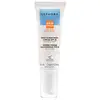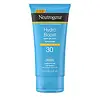Sephora Collection Daily Mineral Sunscreen Cream SPF 30 Versus Neutrogena Hydro Boost Water Gel Lotion Sunscreen SPF 30
What's inside
What's inside
 Key Ingredients
Key Ingredients

 Benefits
Benefits

 Concerns
Concerns

 Ingredients Side-by-side
Ingredients Side-by-side

Zinc Oxide 15.5%
Cosmetic ColorantWater
Skin ConditioningC12-15 Alkyl Benzoate
AntimicrobialCaprylic/Capric Triglyceride
MaskingButyloctyl Salicylate
Skin ConditioningDimethicone
EmollientGlycerin
HumectantButyrospermum Parkii Butter
Skin ConditioningEthylhexyl Palmitate
EmollientPropanediol
SolventCarthamus Tinctorius Oleosomes
EmollientGlyceryl Stearate Se
EmulsifyingPolyhydroxystearic Acid
EmulsifyingSorbitan Isostearate
EmulsifyingCetyl Alcohol
EmollientPentaerythrityl Tetraisostearate
EmollientPhenyl Trimethicone
Skin ConditioningSilica
AbrasiveInulin
Skin ConditioningInulin Lauryl Carbamate
Emulsion StabilisingEthylhexylglycerin
Skin ConditioningHydroxyethyl Acrylate/Sodium Acryloyldimethyl Taurate Copolymer
Emulsion StabilisingPhenoxyethanol
PreservativeHydroxyacetophenone
AntioxidantPolysilicone-11
Xanthan Gum
EmulsifyingGluconolactone
Skin ConditioningTrisodium Ethylenediamine Disuccinate
Sodium Hydroxide
BufferingCitric Acid
BufferingSodium Benzoate
MaskingTocopherol
AntioxidantZinc Oxide 15.5%, Water, C12-15 Alkyl Benzoate, Caprylic/Capric Triglyceride, Butyloctyl Salicylate, Dimethicone, Glycerin, Butyrospermum Parkii Butter, Ethylhexyl Palmitate, Propanediol, Carthamus Tinctorius Oleosomes, Glyceryl Stearate Se, Polyhydroxystearic Acid, Sorbitan Isostearate, Cetyl Alcohol, Pentaerythrityl Tetraisostearate, Phenyl Trimethicone, Silica, Inulin, Inulin Lauryl Carbamate, Ethylhexylglycerin, Hydroxyethyl Acrylate/Sodium Acryloyldimethyl Taurate Copolymer, Phenoxyethanol, Hydroxyacetophenone, Polysilicone-11, Xanthan Gum, Gluconolactone, Trisodium Ethylenediamine Disuccinate, Sodium Hydroxide, Citric Acid, Sodium Benzoate, Tocopherol
Homosalate 15%
Skin ConditioningOctocrylene 10%
UV AbsorberEthylhexyl Salicylate 5%
UV AbsorberButyl Methoxydibenzoylmethane 3%
UV AbsorberAcrylates/Dimethicone Copolymer
Skin ConditioningAlcohol Denat.
AntimicrobialAluminum Starch Octenylsuccinate
AbsorbentBlue 1 Lake
Cosmetic ColorantButyloctyl Salicylate
Skin ConditioningCaprylyl Methicone
Skin ConditioningChlorphenesin
AntimicrobialDimethicone
EmollientDisodium EDTA
Glycerin
HumectantGlyceryl Stearate
EmollientHydrolyzed Hyaluronic Acid
HumectantMenthyl Lactate
MaskingParfum
MaskingPentylene Glycol
Skin ConditioningPhenoxyethanol
PreservativePolyurethane-62
Silica
AbrasiveSodium Acryloyldimethyltaurate/Vp Crosspolymer
Emulsion StabilisingSodium Hydroxide
BufferingStyrene/Acrylates Copolymer
Tocopheryl Acetate
AntioxidantTrideceth-6
EmulsifyingWater
Skin ConditioningHomosalate 15%, Octocrylene 10%, Ethylhexyl Salicylate 5%, Butyl Methoxydibenzoylmethane 3%, Acrylates/Dimethicone Copolymer, Alcohol Denat., Aluminum Starch Octenylsuccinate, Blue 1 Lake, Butyloctyl Salicylate, Caprylyl Methicone, Chlorphenesin, Dimethicone, Disodium EDTA, Glycerin, Glyceryl Stearate, Hydrolyzed Hyaluronic Acid, Menthyl Lactate, Parfum, Pentylene Glycol, Phenoxyethanol, Polyurethane-62, Silica, Sodium Acryloyldimethyltaurate/Vp Crosspolymer, Sodium Hydroxide, Styrene/Acrylates Copolymer, Tocopheryl Acetate, Trideceth-6, Water
 Reviews
Reviews

Ingredients Explained
These ingredients are found in both products.
Ingredients higher up in an ingredient list are typically present in a larger amount.
Butyloctyl Salicylate is a chemical UV filter structurally similar to octisalate. It is a photostabilizer, SPF booster, emollient and solvent. This ingredient helps evenly spread out ingredients.
According to a manufacturer, it is suitable for pairing with micro Titanium Dioxide, Zinc Oxide, and pigments.
Photostabilizers help stabilize UV-filters and prevents them from degrading quickly.
Learn more about Butyloctyl SalicylateDimethicone is a type of synthetic silicone created from natural materials such as quartz.
What it does:
Dimethicone comes in different viscosities:
Depending on the viscosity, dimethicone has different properties.
Ingredients lists don't always show which type is used, so we recommend reaching out to the brand if you have questions about the viscosity.
This ingredient is unlikely to cause irritation because it does not get absorbed into skin. However, people with silicone allergies should be careful about using this ingredient.
Note: Dimethicone may contribute to pilling. This is because it is not oil or water soluble, so pilling may occur when layered with products. When mixed with heavy oils in a formula, the outcome is also quite greasy.
Learn more about DimethiconeGlycerin is already naturally found in your skin. It helps moisturize and protect your skin.
A study from 2016 found glycerin to be more effective as a humectant than AHAs and hyaluronic acid.
As a humectant, it helps the skin stay hydrated by pulling moisture to your skin. The low molecular weight of glycerin allows it to pull moisture into the deeper layers of your skin.
Hydrated skin improves your skin barrier; Your skin barrier helps protect against irritants and bacteria.
Glycerin has also been found to have antimicrobial and antiviral properties. Due to these properties, glycerin is often used in wound and burn treatments.
In cosmetics, glycerin is usually derived from plants such as soybean or palm. However, it can also be sourced from animals, such as tallow or animal fat.
This ingredient is organic, colorless, odorless, and non-toxic.
Glycerin is the name for this ingredient in American English. British English uses Glycerol/Glycerine.
Learn more about GlycerinPhenoxyethanol is a preservative that has germicide, antimicrobial, and aromatic properties. Studies show that phenoxyethanol can prevent microbial growth. By itself, it has a scent that is similar to that of a rose.
It's often used in formulations along with Caprylyl Glycol to preserve the shelf life of products.
Silica, also known as silicon dioxide, is a naturally occurring mineral. It is used as a fine, spherical, and porous powder in cosmetics.
Though it has exfoliant properties, the function of silica varies depending on the product.
The unique structure of silica enhances the spreadability and adds smoothness, making it a great texture enhancer.
It is also used as an active carrier, emulsifier, and mattifier due to its ability to absorb excess oil.
In some products, tiny microneedles called spicules are made from silica or hydrolyzed sponge. When you rub them in, they lightly polish away dead skin layers and enhance the penetration of active ingredients.
Learn more about SilicaSodium Hydroxide is also known as lye or caustic soda. It is used to adjust the pH of products; many ingredients require a specific pH to be effective.
In small amounts, sodium hydroxide is considered safe to use. However, large amounts may cause chemical burns due to its high alkaline.
Your skin has a natural pH and acid mantle. This acid mantle helps prevent harmful bacteria from breaking through. The acid mantle also helps keep your skin hydrated.
"Alkaline" refers to a high pH level. A low pH level would be considered acidic.
Learn more about Sodium HydroxideWater. It's the most common cosmetic ingredient of all. You'll usually see it at the top of ingredient lists, meaning that it makes up the largest part of the product.
So why is it so popular? Water most often acts as a solvent - this means that it helps dissolve other ingredients into the formulation.
You'll also recognize water as that liquid we all need to stay alive. If you see this, drink a glass of water. Stay hydrated!
Learn more about Water